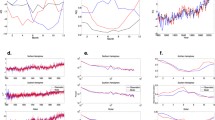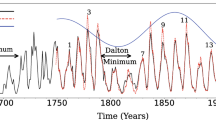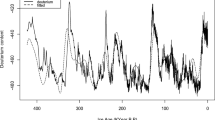Abstract
The stochastic behavior of the length of day (LOD) process is analyzed and is modeled within statistical accuracy on a time-scale ranging from weeks to millennia by a three-component model comprising a global Brownian motion process, decadal fluctuations, and a 50-day Madden–Julian oscillation. While the model is intended to be phenomenological, some possible physical models underlying the three components are speculated upon. The model is applied to estimate long-range extrapolation errors. For example, it predicts a standard error of 1 h in the clock-time correction ΔT for extrapolation by 1,500 years from 500 to 2000 BC.
Similar content being viewed by others
References
Aldridge KD, Bloxham J, Dehant V, Gubbins D, Hide R, Hinderer J, Hutcheson KA, Jault D, Jones CA, Legros H, LeMouël J-L, Lloyd D, Wahr JM, Whaler KA, Zhang K (1990) Core–mantle interactions. Surv Geophy 11(4):329–353 DOI 10.1007/BF01902965
Bloomfield P (1976) Fourier analysis of time series: an introduction. Wiley, New York
Chao BF, Gross RS (2005) Did the 26 December Sumatra, Indonesia, earthquake disrupt the Earth’s rotation as the mass media have said?. EOS—Trans AGU 86:1–2
Chatfield C (1989) The analysis of time series: an introduction, 4th edn. Chapman and Hall, London
Hamdan K, Sung L-Y (1996) Stochastic modeling of length of day and universal time. J Geodesy 70:307–320
Hendon HH (1995) Length of day changes associated with the Madden–Julian oscillation. J Atmos Sci 52:2373–2383
Hide R, Dickey JO (1991) Earth’s variable rotation. Science 253:629–637
Huber PJ (1999–2000) Astronomical dating of Ur III and Akkad. Archiv für Orientforschung 46/47:50–79
Huber PJ, De Meis S (2004) Babylonian eclipse observations from 750 BC to 1 BC. Istituto Italiano per l’Africa e l’Oriente, Mimesis, Milano
Jordi C, Morrison LV, Rosen RD, Salstein DA, Rosselló G (1994) Fluctuations in the Earth’s rotation since 1830 from high-resolution astronomical data. Geophys J Int 117:811–818
Liu C-Y (2002) An early solar eclipse record—“Tiandayi” in the 10th century BC. Chin J Astron Astrophys 2:391–395
Madden RA, Julian PR (1971) Detection of a 40–50 day oscillation in the zonal wind in the tropical pacific. J Atmos Sci 28:702–708
Morrison LV, Stephenson FR (1982) Secular and decade fluctuations in the Earth’s rotation: 700 BC – AD 1978. In: Fricke W, Teleki G (eds) Sun and planetary system. Reidel, Dordrecht, pp 173–178
Morrison LV, Stephenson FR (2004) Historical values of the Earth’s clock error DT and the calculation of eclipses. J Hist Astron 35:327–336
Muller PM (1975) An analysis of the ancient astronomical observations with the implications for geophysics and cosmology. Ph.D. Thesis, University of Newcastle
Muller PM, Stephenson FR (1975) The acceleration of the Earth and Moon from early astronomical observations. In: Rosenberg GD, Runcorn SK (eds) Growth rhythms and history of the Earth’s rotation. Wiley, London
Munk W, Macdonald G (1975) The rotation of the Earth. Cambridge University Press, Cambridge
Munk W, Revelle R (1952) Sea level and the rotation of the Earth. Am J Sci 250:829–833
Slutsky E (1927) The summation of random causes as the source of cyclic processes (in Russian). Probl Econ Cond 3:1. English trans. in Econometrica 5:105 (1937)
Stephenson FR (1997) Historical eclipses and Earth’s rotation. Cambridge University Press, Cambridge
Stephenson FR (2003) Historical eclipses and Earth’s rotation. Astron Geophys 44(2): 2.22–2.27
Stephenson FR, Morrison LV (1984) Long-term changes in the rotation of the Earth: 700 BC to AD 1980. Phil Trans R Soc Lond A 313:47–70
Stephenson FR, Morrison LV (1995) Long-term fluctuations in the Earth’s rotation: 700 BC to AD 1990. Phil Trans R Soc Lond A 351:165–202
Varga P, Gambis D, Bus Z, Bizouard Ch (2005) The relationship between the global seismicity and the rotation of the Earth. In: Capitaine N (ed) Proceedings of the “Journées 2004 Systèmes de Référence Spatio-Temporels”, Observatoire de Paris
Yoder FY, Williams JG, Parke ME (1981) Tidal variations of Earth rotation. J Geophys Res 86:881–891
Zhang C (2005) Madden-Julian oscillation. Rev Geophys 43:RG2003 DOI 10.1029/2004RG000158
Author information
Authors and Affiliations
Corresponding author
Rights and permissions
About this article
Cite this article
Huber, P.J. Modeling the length of day and extrapolating the rotation of the Earth. J Geodesy 80, 283–303 (2006). https://doi.org/10.1007/s00190-006-0067-3
Received:
Accepted:
Published:
Issue Date:
DOI: https://doi.org/10.1007/s00190-006-0067-3




